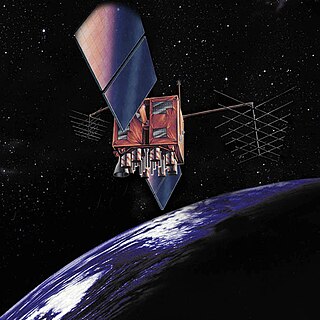
GPS Block III consists of the first ten GPS III satellites, which will be used to keep the Navstar Global Positioning System operational. Lockheed Martin designed, developed and manufactured the GPS III Non-Flight Satellite Testbed (GNST) and all ten Block III satellites. The first satellite in the series was launched in December 2018.
USA-87, also known as GPS IIA-8, GPS II-17 and GPS SVN-29, was an American navigation satellite which formed part of the Global Positioning System. It was the eighth of nineteen Block IIA GPS satellites to be launched.

GPS satellite blocks are the various production generations of the Global Positioning System (GPS) used for satellite navigation. The first satellite in the system, Navstar 1, was launched on 22 February 1978. The GPS satellite constellation is operated by the 2nd Space Operations Squadron (2SOPS) of Space Delta 8, United States Space Force.
USA-35, also known as Navstar 2-01, GPS II-1 and GPS SVN-14, was an American navigation satellite which formed part of the Global Positioning System. It was the first of nine Block II GPS satellites to be launched, which were the first operational GPS satellites to be launched.
USA-79, also known as GPS IIA-3, GPS II-12 and GPS SVN-25, was an American navigation satellite which formed part of the Global Positioning System. It was the third of nineteen Block IIA GPS satellites to be launched.
USA-83, also known as GPS IIA-5, GPS II-14 and GPS SVN-26, is an American navigation satellite which forms part of the Global Positioning System. It was the fifth of nineteen Block IIA GPS satellites to be launched.
USA-84, also known as GPS IIA-6, GPS II-15 and GPS SVN-27, is an American navigation satellite which forms part of the Global Positioning System. It was the sixth of nineteen Block IIA GPS satellites to be launched.
USA-85, also known as GPS IIA-7, GPS II-16 and GPS SVN-32, was an American navigation satellite which formed part of the Global Positioning System. It was the seventh of nineteen Block IIA GPS satellites to be launched.
USA-90, also known as GPS IIA-10, GPS II-19 and GPS SVN-31, was an American navigation satellite which formed part of the Global Positioning System. It was the tenth of nineteen Block IIA GPS satellites to be launched.
USA-91, also known as GPS IIA-11, GPS II-20 and GPS SVN-37, was an American navigation satellite which formed part of the Global Positioning System. It was the eleventh of nineteen Block IIA GPS satellites to be launched.
USA-94, also known as GPS IIA-13, GPS II-22 and GPS SVN-35, was an American navigation satellite which formed part of the Global Positioning System. It was the thirteenth of nineteen Block IIA GPS satellites to be launched.
USA-96, also known as GPS IIA-14, GPS II-23 and GPS SVN-34, is an American navigation satellite which is part of the Global Positioning System. It was 14 of 19 Block IIA GPS satellites to be launched, and the last one to be retired.
USA-117, also known as GPS IIA-16, GPS II-25 and GPS SVN-33, is an American navigation satellite which forms part of the Global Positioning System. It was the sixteenth of nineteen Block IIA GPS satellites to be launched.
USA-126, also known as GPS IIA-17, GPS II-26 and GPS SVN-40, is an American navigation satellite which forms part of the Global Positioning System. It was the seventeenth of nineteen Block IIA GPS satellites to be launched.
USA-135, also known as GPS IIA-19, GPS II-28 and GPS SVN-38, is an American navigation satellite which forms part of the Global Positioning System. It was the last of nineteen Block IIA GPS satellites to be launched.

USA-132, also known as GPS IIR-2 and GPS SVN-43, is an American navigation satellite which forms part of the Global Positioning System. It was the second Block IIR GPS satellite to be launched, out of thirteen in the original configuration, and twenty one overall. GPS IIR-1 failed to achieve orbit, so USA-132 was the first successful Block IIR satellite. It was built by Lockheed Martin, using the AS-4000 satellite bus.
USA-1, also known as Navstar 9, GPS I-9 and GPS SVN-9, was an American navigation satellite launched in 1984 as part of the Global Positioning System development programme. It was the ninth of eleven Block I GPS satellites to be launched, and the first satellite to receive a USA designation.
USA-5, also known as Navstar 10, GPS I-10 and GPS SVN-10, was an American navigation satellite launched in 1984 as part of the Global Positioning System (GPS) development programme. It was the tenth of eleven Block I GPS satellites to be launched.

USA-266, also known as GPS IIF-12, GPS SVN-70 and NAVSTAR 76, is an American navigation satellite which forms part of the Global Positioning System. It was the twelfth of twelve Block IIF satellites to be launched.





